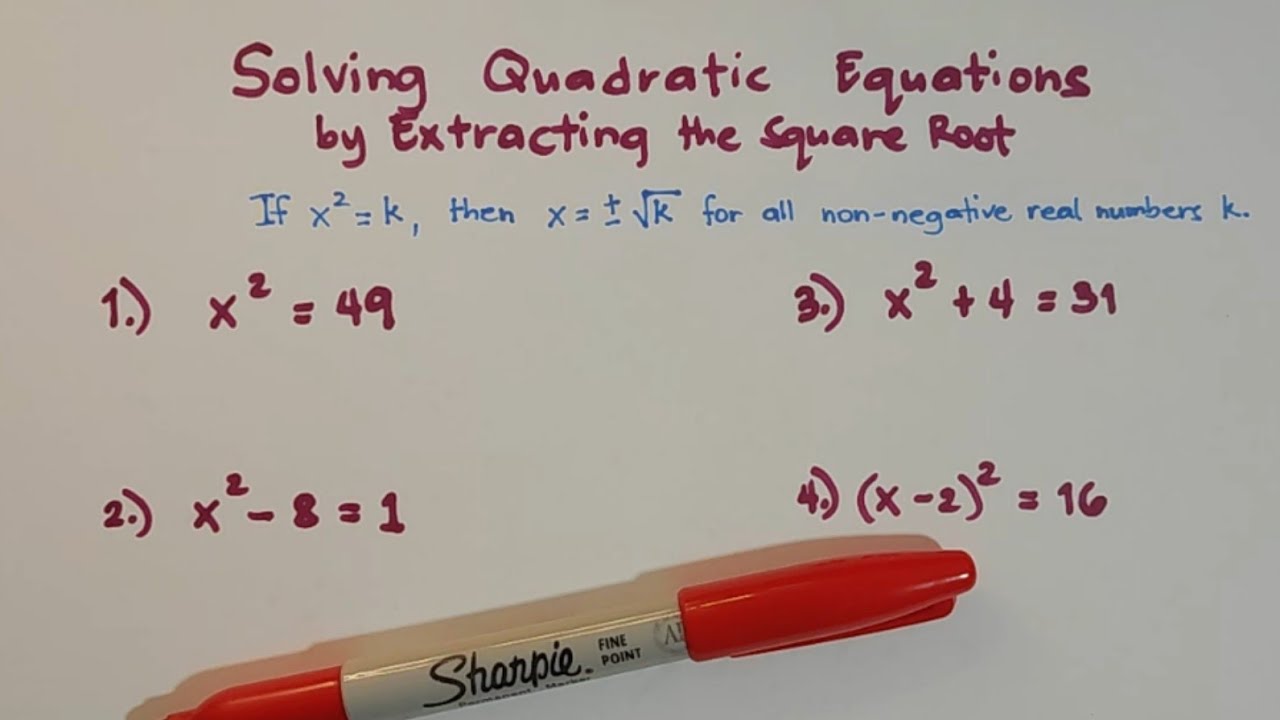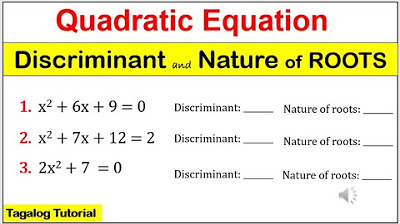Solving Square Roots with Imaginary Solutions
Summary
TLDRThis video tutorial teaches solving quadratic equations with imaginary solutions using square roots. It covers isolating x-squared, applying square roots to both sides, and handling absolute values. Examples include equations like x^2 + 4 = 0 leading to solutions like ±2i, and more complex scenarios like (x-4)^2 = -8, resulting in x = 4 ± 2√2i. The video also addresses equations with variables inside parentheses and fractions, emphasizing the importance of order in writing solutions.
Takeaways
- 🔢 Solving quadratic equations with imaginary solutions involves taking square roots of negative numbers.
- 📐 When isolating x^2 and taking the square root, the result represents the absolute value of x.
- 🧮 The square root of a negative number can be broken down into i (the square root of -1) multiplied by the square root of the positive number.
- 📉 For equations like x^2 = -4, the solution is x = ± 2i, indicating both positive and negative imaginary numbers.
- 🔄 When dealing with equations like 3x^2 = 27, dividing by the coefficient of x^2 isolates the term before taking the square root.
- 📌 The absolute value notation indicates that x could be either positive or negative, so solutions are given as x = ± √-9.
- 🤔 For equations where x is inside parentheses, such as (x-4)^2 = -8, first isolate the squared term and then solve for x.
- 🔄 When solving equations with fractions or complex coefficients, like (-1/2x + 1)^2 = 25, simplify the equation before taking the square root.
- 📘 The order of operations for writing solutions is: numbers first, then letters, and finally square roots.
- 🔗 When an equation has x inside a squared term, you must consider both positive and negative square roots to find the complete solution.
Q & A
What is the first step when solving a quadratic equation with imaginary solutions?
-The first step is to isolate the x squared term, ensuring there are no x terms left on the equation.
How do you solve the equation x squared plus 4 equals 0?
-You subtract 4 from both sides to get x squared equals negative 4, then take the square root of both sides to find x equals positive or negative 2i.
What does the square root of a negative number represent?
-The square root of a negative number represents an imaginary number, where the square root of negative one is denoted by 'i'.
How do you handle the absolute value when solving quadratic equations with imaginary solutions?
-The absolute value signifies the distance from zero, which means the solution could be either positive or negative, representing both possibilities.
What is the solution to the equation 3x squared equals 27?
-After dividing both sides by 3, you get x squared equals negative nine, and taking the square root gives x equals positive or negative 3i.
Can you provide an example of breaking down a square root into simpler components?
-Yes, for the equation x squared equals negative 32, you can break down the square root of 32 into 4 times the square root of 2 times negative one, which simplifies to 4i.
How do you solve equations where x is inside a set of parentheses?
-First, you isolate the squared term, then take the square root of both sides, and finally solve for x by considering both positive and negative possibilities.
What is the process for solving equations with complex coefficients like in the example 'three times (x minus four) squared equals negative twenty-four'?
-You divide by the coefficient to isolate the squared term, take the square root of both sides, consider both positive and negative solutions due to the absolute value, and then solve for x.
How do you handle fractions in quadratic equations?
-You can either multiply by the denominator to clear the fraction or simplify the equation by subtracting a constant to make it easier to solve.
What is the final step when solving for x in the equation 'negative 1/2 x plus 1 squared equals 26'?
-After taking the square root and simplifying, you subtract 1 from both sides to solve for x, resulting in x equals negative one plus or minus 5i root 2.
Why is it important to put the number before the plus or minus sign when solving for x in equations with absolute values?
-Placing the number before the plus or minus sign ensures that the number is correctly associated with both the positive and negative possibilities of the solution.
Outlines

Dieser Bereich ist nur für Premium-Benutzer verfügbar. Bitte führen Sie ein Upgrade durch, um auf diesen Abschnitt zuzugreifen.
Upgrade durchführenMindmap

Dieser Bereich ist nur für Premium-Benutzer verfügbar. Bitte führen Sie ein Upgrade durch, um auf diesen Abschnitt zuzugreifen.
Upgrade durchführenKeywords

Dieser Bereich ist nur für Premium-Benutzer verfügbar. Bitte führen Sie ein Upgrade durch, um auf diesen Abschnitt zuzugreifen.
Upgrade durchführenHighlights

Dieser Bereich ist nur für Premium-Benutzer verfügbar. Bitte führen Sie ein Upgrade durch, um auf diesen Abschnitt zuzugreifen.
Upgrade durchführenTranscripts

Dieser Bereich ist nur für Premium-Benutzer verfügbar. Bitte führen Sie ein Upgrade durch, um auf diesen Abschnitt zuzugreifen.
Upgrade durchführenWeitere ähnliche Videos ansehen

Bilangan Kompleks • Part 2: Bilangan Imajiner

Solving Quadratic Equations by Extracting the Square Roots by @MathTeacherGon

How to Solve Quadratic Equations by Extracting the Square Root? @MathTeacherGon

SOLVING QUADRATIC EQUATIONS USING QUADRATIC FORMULA | Grade 9 Learning Task 3 Week 1

MATH9 DISCRIMINANT and NATURE OF ROOTS of quadratic equation #math9 #discriminant #natureofroots

Akar-akar persamaan kuadrat bagian 2 : Melengkapi kuadrat sempurna
5.0 / 5 (0 votes)
